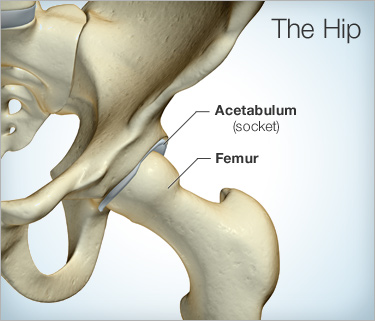If So, You Are in Good Company
 At the risk of sounding like orthopedic cheerleaders, we have to declare: There’s never been a better time to have that hip replaced.
At the risk of sounding like orthopedic cheerleaders, we have to declare: There’s never been a better time to have that hip replaced.
With more than 50 years of history, this surgical procedure has become almost routine, with nearly 300,000 operations performed each year. Two and a half million Americans now live with an artificial hip.
There are several reasons for the popularity. One, our population is aging and arthritis, which is a leading cause of hip immobility, is on the rise. Two, surgical techniques have improved to the point where patients can expect to spend less time in the hospital and eventually resume most of their regular activities.
Are You Ready Now?
Arthritis, in its various forms, is the most common reason for chronic hip pain and disability. Osteoarthritis wears away cartilage, which cushions the hip bones. Other types of arthritis are rheumatoid (caused by an autoimmune disease) and post-traumatic arthritis (damage as a result of an injury).
At the clinic, we can see evidence of arthritis on imaging tests. You, on the other hand, may experience stiffness and pain when you move your hips and while at rest. When the hip reaches the point where you start to avoid your everyday activities, and the usual therapies (anti-inflammatory drugs, support devices such as a cane or walker) no longer provide relief, you could be a candidate for hip replacement.
Not the Same Old Joint
By now, you are probably familiar with how the hip joint works. To simplify: a bony ball fits into the socket in your pelvic bone; slippery cartilage enables the joint to roll smoothly as you walk, stretch or bend.
 A total hip replacement involves the following:
A total hip replacement involves the following:
- Removal of the femoral head, the bony knob of the hip, and replacement with a metal part that fits into the hollow socket of the femur bone
- Implantation of a synthetic ball where the femoral head used to be
- Removal of cartilage, to be replaced with a metal socket
- Plastic, metal or ceramic spacer inserted between the new ball and socket to allow a smooth, gliding motion
There is no upper age limit or weight restrictions for hip replacement surgery. (In fact, there is no lower age limit either, and young teenagers with juvenile arthritis are also candidates.) Most people who have this operation are between the ages of 50 and 80 but each patient is evaluated individually.
We ask about your general health, your lifestyle and how it’s affected by arthritis, as well as your medical history. We also perform a physical exam to assess your mobility, strength and hip alignment. X-rays and other imaging tests such as MRI help us assess the extent of the damage.
How Soon Can I Walk/ Dance/ Climb Stairs?
Most patients find their situation vastly improved after hip replacement, but again, it depends on the individual. If you are overweight, that factor could place extra strain on the new joint. The same is true if you overdo it. While you should be able to walk, bike, drive, swim, play golf, dance and engage in other low-impact sports or activities, we generally advise against running, jogging, jumping or playing other high-impact sports. (Sorry, no touch football in the backyard!)
Your rehabilitation is critical for full recovery. A physical therapist will have you walking and performing light exercises within a day after your surgery. He or she will also show you specific exercises to strengthen the hip, and how to perform daily activities without risking a set-back.
You should have your home set up for the recovery period, with safety bars in the bathroom, a raised toilet seat, aids for dressing yourself and a grabber for picking up things off the floor.











